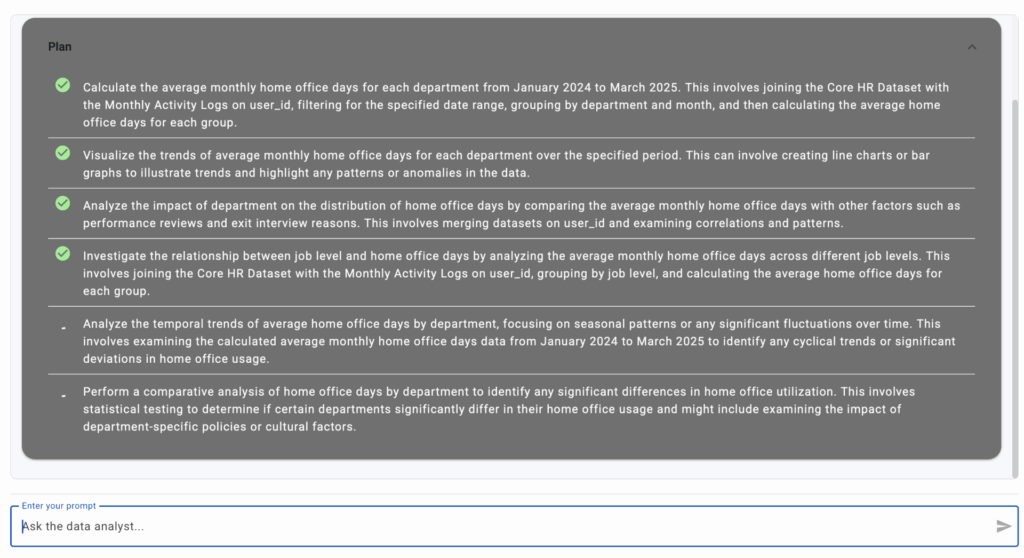We believe artificial intelligence has now entered almost every area of our daily lives. It’s clear that tasks related to information processing and analytics are ideal use cases, and AI’s capabilities can be confidently relied upon. Human resources is one of the business domains where expectations toward AI are especially high. Let’s take a look at a specific example and see what results we’ve achieved.
A Thought Experiment
Imagine that your company suddenly sees a significant spike in employee resignations. And not just regular turnover—key employees, difficult to replace, are leaving. The HR team quickly reacts, gathers, and begins the guessing game:
“Is the work too stressful?”
“Are salaries no longer competitive?”
“Is it leadership or project-related issues?”
But assumptions alone are not enough. We need real, data-driven answers—and fast.
What Usually Happens?
Management gives the directive, and a data collection frenzy begins: exit interviews, employee satisfaction surveys, absence and sick leave records, salary changes, home office usage, possibly even project allocations and performance data. Then an analyst or IT team writes queries, builds tables, prepares charts—and after a few days (or weeks), a report is generated. If new questions arise? The whole process starts over.
This is slow, costly, and often only produces results when the problem has already grown too large.
What If We Could Automate This?
At Nitrowise, we developed an AI agent-based analytics system that replicates the essential tasks of a data analyst—without human intervention, but much faster and highly scalable.
This system:
- Understands HR-related questions
- Gathers relevant data from multiple sources
- Cleans and analyzes the data
- Designs a logical analysis plan
- Processes documents and notes as additional data sources
- Generates and executes the necessary queries and computations
- Evaluates results
- Recommends further analysis or next steps
In the end, it delivers a well-structured, easy-to-understand report—just like a senior analyst, only in a fraction of the time.
A Real HR Turnover Scenario
Let’s say we ask:
“Is the rising resignation rate related to a reduction in home office flexibility?”
The system works through a chat interface where the HR colleague can simply ask this question—just like chatting with a data analyst on Slack or Teams.
The AI agent:
- Identifies the relevant data sources
- Interprets the question and creates a proposed data model
- Executes the analysis automatically
- And for example, shows that in departments where home office was reduced, the resignation rate increased by 2.5 times
If clarification is needed, the system follows up via chat and can even suggest new questions for deeper insights.
Technological Background: AI Agents and Frameworks
In recent years, not only have AI models rapidly evolved, but so have the frameworks that support transparent and efficient AI-powered processes. Our solution is built on Langchain and LangGraph—frameworks that simplify and scale the modeling of AI workflows.
Using LangGraph, we represent the analyst’s process as a dynamic, directed graph that clearly separates individual steps, decision points, and feedback loops. For instance, when an analytical agent delivers new findings, the dynamic planning agent automatically revises the process to determine if the previous steps are still relevant or new tasks should be generated.
This agent-based approach allows us to create modular, reusable entities with clearly defined roles—usable across multiple analytical scenarios. Another benefit: we’re not locked into a single model. Depending on the task, we might use a high-reasoning model (like GPT-4o mini) for planning, and a more cost-effective one for code generation or analysis. Sensitive processes can even run on fully local models like Qwen3 32B.
All generated code, queries, and conclusions are validated logically, documented, saved, and reproducible—ensuring transparency and auditability.
From Data to Report – AI Agents at Work
To get started, users simply provide the data sources—relational databases or CSV/TSV files. The system then performs a schema scan, mapping field types, analyzing value distributions, and checking data format consistency.
A data-cleaning agent can fix smaller issues. Then, a chat-based session begins where the planning agent uses the known schema to generate an initial analysis plan. Specialized agents for code writing, execution, and validation carry out the analytics while continuously interpreting the results.


Based on outcomes, the planner agent decides if further steps or revisions are needed. Once enough insight is gathered, a final reporting plan is created and executed by a dedicated reporting agent.
The entire process is visible through an intuitive chat interface showing execution status, current plan, and any modifications made along the way.
Data Security and Traceability
In our system, data protection isn’t an afterthought—it’s foundational. Our AI agents rely solely on predefined prompt templates and strict parameters, ensuring that no personal or sensitive data leaves the enterprise environment.
LangSmith-based traceability enables full audit logs of every AI interaction, so all analyses and processing can be tracked, verified, and fully compliant. We not only ensure your data is safe—we can prove it at any time.
Results: Fast, Reliable, Actionable
- Reports ready in minutes, not weeks
- Decisions based on facts, not guesses
- Proactive responses, not reactive firefighting
- Retention of key employees through targeted, data-driven actions
This Isn’t a Theory – It Works
We’re happy to demonstrate the system in action or run a proof-of-concept using your data. If you believe HR efficiency can be boosted with AI, we’re ready to talk.
We’ll help you explore how AI agents can deliver value in your organization—not just in HR, but across all data-driven domains.